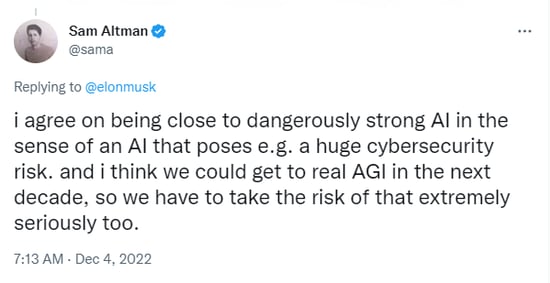Jack Colreavy
- Jan 17, 2023
- 4 min read
ChatGPT and its broad applications
Every Tuesday afternoon we publish a collection of topics and give our expert opinion about the Equity Markets.

Welcome to 2023 and the first edition of ABSI for the year. There were many interesting stories over the holiday period but one that continued to pop up was the release of ChatGPT. Released in November 2022, ChatGPT has quickly garnered attention (both positive and negative) for its ability to mimic human conversation and journalism. ABSI this week will introduce you to ChatGPT and its broad applications.
For the uninitiated, ChatGPT (Generative Pre-trained Transformer) is a large language model developed by OpenAI that is trained on a massive dataset of text data. It uses a neural network architecture known as a transformer, which is able to understand and generate natural language with a high degree of accuracy. The model has been trained on a diverse range of text, including books, articles, and websites, allowing it to have a broad knowledge base.
One of the key features of ChatGPT is its ability to generate human-like text, making it well-suited for tasks such as chatbots, text completion, and language translation. However, it can struggle with understanding and generating text that is not similar to the text it was trained on. This can lead to errors and biases in the model's output.
To give you an idea of the power of ChatGPT, the last two paragraphs were written by the model after I asked it for an overview of itself.

Source: ChatGPT
Reception towards the breakthrough Natural Language Processing (NPL) model has been mostly positive with reviews praising the detail and “human-like” text it is able to produce. Moreover, it is one of the first demonstrations to the general public as to the power of AI and the accessibility of the tools; akin to web browsers unlocking the accessibility of the internet to those outside of the technology industry.
However, with great power comes great responsibility and the negative reactions revolve around the software being used for nefarious purposes. In the wrong hands, ChatGPT could be used to write scam or phishing emails posing a cybersecurity risk. This was acknowledged by the CEO of OpenAI, Sam Altman, who once tweeted in response to Elon musk that a strong AI poses a “huge cybersecurity risk”.
Source: Twitter
In addition to cybersecurity, the advent of ChatGPT is causing headaches for academia as the model is being used to write essays for students. Already there are countless stories of students using the software to assist or completely write assignments and for teachers, it is difficult to monitor and determine if a piece of work was written by the student or ChatGPT. For now, the biggest red flag is the improvement in grammar not corresponding with a student’s previous work. However, tools are already starting to propagate to detect AI essays with the most popular, GPTZero, being developed by a 22 year old Princeton student.
Source:Technavio
Overall, ChatGPT is a significant step forward in the field of NLP, with an interface that makes it accessible to the masses for a wide range of applications. However, the model still carries major flaws and biases that will be difficult to iron out. Nevertheless, it is the best example yet of the power of AI and paints a bright future for its deployment.
We offer value-rich content to our BPC community of subscribers. If you're interested in the stock market, you will enjoy our exclusive mailing lists focused on all aspects of the market.
To receive our exclusive E-Newsletter, subscribe to 'As Barclay Sees It' now.
Share Link










